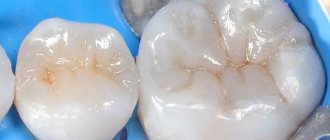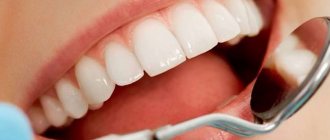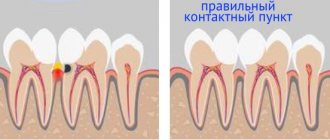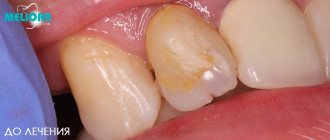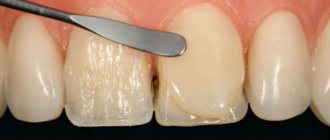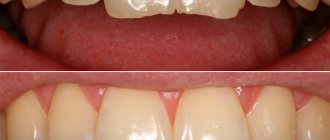Caries is one of the most common dental diseases; it manifests itself in the destruction of hard tooth tissues. First, a small defect appears on the enamel, which, in the absence of proper timely treatment, turns into a carious cavity. The main method of treating caries is to remove the affected tissue and restore the tooth using special filling materials.
The quality of therapeutic dental treatment largely depends on the quality of the material used for filling. Today, light-curing fillings, which are often also called light, light-composite or photopolymer, are very popular in dental clinics.
Features of the light seal
The material for the manufacture of a light-curing filling is a composite, which polymerizes under the influence of ultraviolet radiation. The layer-by-layer technology, in which the photocomposite layer does not exceed 2 mm, gives the installed filling high strength and durability. And the plasticity of the material allows you to restore the natural shape of the tooth.
These positive properties of the filling are directly related to its rather complex composition:
- The polymer matrix is the basis of the filling. When exposed to light, the material breaks down into radicals that promote hardening.
- Filler. Silicon dioxide, glass ceramics and other types of filler form the structure and color of the filling.
- Additional substance.
A significant advantage of a light-composite filling is the complete absence of substances harmful to the human body; it is absolutely non-toxic.
Light-curing composite fillings, depending on the composition of the filler, are of the following types:
- Microfilled (ideal for recreating the tooth structure in the smile area). Small filler particles retain their color well, are easy to polish, but are quite fragile and cannot withstand heavy chewing loads, so they are recommended for installation on the front teeth.
- Macro-filled (most often used for chewing teeth). Thanks to macrophiles, which are large solid particles, the filling is quite solid. However, given the roughness of the surface and the ability to lose its color over time, it is installed on the chewing teeth or on the inside, where the filling is not so noticeable.
- Mini-filled (proven well for filling cavities of classes I and II). Fillings are characterized by high strength, they are resistant to abrasion, but there is no opportunity to polish the surface to a perfect shine.
- Nanohybrid (universal). Ultrafine particles of mini- and micro-filled composites, which are part of the filling material, are durable and look aesthetically attractive. Such fillings are suitable for all types of restoration.
Light fillings are a universal solution in modern dentistry, because the dentist has ample opportunities to choose for each patient his own shade of material, which does not change color when using products that stain teeth enamel. This valuable property of a photopolymer filling is especially important in the treatment and restoration of anterior teeth, as it allows you to completely restore the functionality and aesthetics of a damaged tooth and return the beauty of a smile to the patient.
So, the advantages of light polymerization fillings include:
- soft consistency of the filling composition. This allows you to qualitatively fill the entire cavity and ensures a tight fit to the edges of the tooth;
- high plasticity of the material. The specialist has the opportunity to shape the crown part of the tooth without fear of premature hardening. The seal gains its strength only under the influence of an ultraviolet lamp;
- hypoallergenic and non-toxic composition. The filling is harmless to the patient’s body and has no restrictions for installation by pregnant and nursing mothers;
- wide palette of shades. During restoration, a color identical to the patient’s enamel is selected;
- Composite compliance. The material is convenient to polish and easy to grind.
Ormokers
Ormokers are ORGANIC MODIFIED CERAMICS. This type of material consists of particles - barium glass, fluorapatite, which form an organic matrix. The size of particles in ormokers reaches up to 1.7 microns. Ormokers are well filled up to 70% by volume. Ormokers have good strength; some literature sources even recommend the use of ormokers in patients with allergies to composites, but there are no confirmed clinical cases. The positive properties of ormokers, which leads to their use in restoration of any class according to Black, include:
- Good strength;
- Minimal shrinkage;
- Wear resistance;
- Aesthetics;
- Polishability.
However, in terms of their application, ormokers are inferior to microhybrid composites.
Silorans
Siloranes are representatives of a new era of substances in dentistry. Siloranes also contain substances used in the chemical industry. However, this material is distinguished by its good biocompatibility, low shrinkage, and wear resistance. Silorans have a convenient working time, which reaches up to 9 minutes in the presence of general lighting.
Siloranes are used to restore Black class 1–2. There are some nuances in working with silorans. The first is the need to install a gasket; the second is its incompatibility with adhesive systems of compomers and flowable composites. However, silorans are pleasant to work with: they do not stick to the tool, pack well and are polished.
At this point in time, unfortunately, there are no long-term clinical results with the use of silorans, but the prospects for this group of materials are not bad!
Compomers
Compomers are a duo of composite and glass ionomer cement. This group of materials combines the properties of both composite and GIC. The curing mechanism of compomers is described as a cascade, where first polymerization occurs under the influence of light, and then under the influence of water an acid-base reaction characteristic of cement is activated.
Compomers have the following properties:
- Elastic filling material;
- Fluoride release;
- Undemanding to working conditions: can be applied in large portions, does not require careful isolation from water, you can skip the pickling stage;
- Reacts less to specifically targeted rays of the polymerization lamp.
With such properties, the compomer is used to restore Black classes 3 and 5, restorations on baby teeth, and fissure sealing.
Service life and care of the filling after its installation
On average, the service life of a filling made from a light-curing composite is more than 6 years, but this period can increase and theoretically the filling can last a lifetime. Its quality also depends on the level of professionalism of the doctor and the patient’s compliance with the basic recommendations of the treating dentist after its installation.
There is no need to take special care of the photopolymer filling after installation; it is enough to follow simple rules at first.
Tips to help extend the “life” of the filling and maintain its aesthetic properties:
- refrain from eating immediately after installing the filling for 1-2 hours;
- During the first 3 days, limit the consumption of foods that are coloring and aggressive to tooth enamel (coffee/tea, wine, lemon, beets and, of course, any carbonated drinks). Such precautions are necessary in order to preserve the original shade of the filling;
- give up sweet and flour products, eat more fruits, vegetables and grains, then the filling will not lose its qualities and properties;
- Carefully monitor your oral hygiene and do not forget about preventive examinations every six months.
From the above, we can conclude that it is possible to eliminate toothache, prevent tooth decay and preserve the beauty of your smile by contacting a dental clinic in a timely manner. Only a qualified dentist will be able to select the correct filling material and professionally install a durable filling.
Technology of using light-curing composite
There is a wide range of polymer composites available and, for the most part, they are made from resins. The composition is a one-component composite that does not require mixing, and thus simplifies the dentist’s work. The structure of composites is a paste or fluid material. As a curing stimulator, they contain a light-absorbing substance - a photoinitiator. The fluid structure of the composite allows it to penetrate into the smallest cavities of the tooth, creating a thin and dense layer. The material is applied into the tooth cavity in small portions and carefully distributed throughout it. Next, the fluid layer of the composite is cured with a special dental lamp - a photopolymerization device that produces high-intensity blue light with a wavelength of 400-500 nm. After the layer has completely cured, a new layer of material is applied, and so on until the existing tooth cavity is completely filled with polymer.
Dentistry price list
Where to find a highly qualified dentist in Ivanteevka?
At the Sanident clinic, one of the largest in Ivanteevka, specialists with extensive experience are ready to provide professional dental care and treat teeth at reasonable prices. We have a flexible system of discounts, hold promotions, and provide guarantees for all types of dental services.
You can make an appointment with a dentist at a time convenient for you. We use an individual approach and strive to make treatment comfortable for each patient. Our dentistry has an impeccable reputation and a large number of positive reviews.
Dentistry "Sanident" is located at the following addresses:
- Ivanteevka, st. Novoselki, 4;
- Shchelkovo, st. Central, no. 80.
Contraindications
Despite the fact that this type of filling has a number of significant advantages over traditional analogues (for example, due to its high plasticity, the material does not harden prematurely, and the dentist can easily fill the entire tooth cavity without disturbing its anatomical features), it is not always possible to install them. Limitations and contraindications for light filling:
- Location of the dental unit. In hard-to-reach places it is impossible to ensure sufficient polymerization, which negatively affects the quality of work. In such cases, it is better to give preference to classic chemical fillings.
- Duration of wearing. It is important to consider whether the patient needs a temporary or permanent filling. To install a temporary filling, photopolymer materials are an unreasonably expensive “pleasure.” This type of filling is best installed for a long period.
- Childhood. Dentists do not recommend this procedure for patients under 13 years of age. The physiological characteristics of the child’s body, for example, increased salivation or fragile tooth buds that cannot withstand the load, as well as the conditions for filling (the child often closes his mouth) make the procedure undesirable at a young age.
Installation of a photopolymer filling
Light filling is carried out in several stages, and the stage of preparing the dental cavity for the installation of a filling is no different from conventional dental treatment. Procedure:
- preliminary cleaning and treatment of problematic teeth;
- formation of material according to the anatomical features of the tooth;
- exposure of the material to an ultraviolet radiation lamp to harden it;
- grinding and polishing;
- At the final stage, the filling is coated with varnish to create a protective layer.
After the product is coated with a special varnish composition, the installation is completed. You can eat and drink immediately. However, if the tooth under the filling hurts all day after installation, and the intensity of the pain does not decrease, you should consult a doctor.
